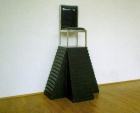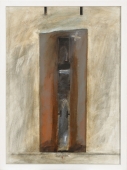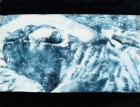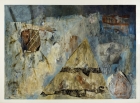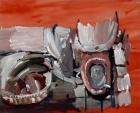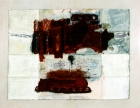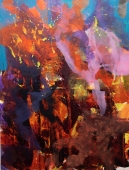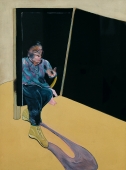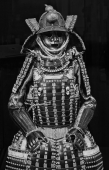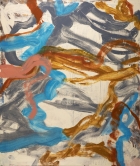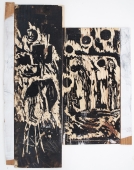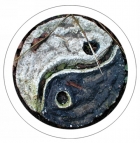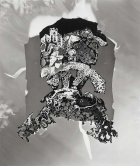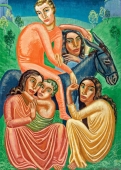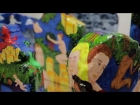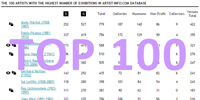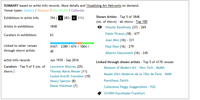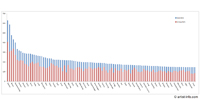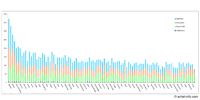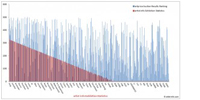
Artist | Walter De Maria (1935 - 2013)
https://www.artist-info.com/artist/Walter-de-Maria
Biography
Biography
born in 1935
About the work (english / deutsch)
About the work (english / deutsch)
In General
We are very fortunate in being able to show in a German museum four important early works by the American minimalist Walter De Maria: Cage (1965), Pyramid Chair (1966), 4-6-8 Series (1966/91) und Circle, Square, Triangle (1972). All these works came from Darmstadt to Frankfurt upon the acquisition of a greater part of the Ströher Collection, and on the artist's suggestion they will be shown in varying constellations. On entering the room we are confronted quite suddenly with the cold splendour and metallic gleam of a number of floor sculptures. It is immediately obvious that all four works have been produced along strict geometric line and are free of any decorative additions. Other common elements worth nothing are the use of regular mathematical systems, a clearly objectifiable presence in space and the prevalence of gleaming polished metal surfaces.
Pyramid Chair
As in the case of Cage, the title of Pyramid Chair (1966) describes the concrete form visible to us. On the platform that tops a three-sided black pyramid made -up of steep stairs, there stands a chair, executed in strict rectangular form. This chair was a prototype, which was designed by order of an American entrepreneur, but never went into production. The gleaming polished chromium-plated steel and the black patent leather upholstery remind one of the cool elegance of Sixties offices furniture. However, the impression of apparent functionality is quickly destroyed. It is impossible to get to the chair by means of such steep steps. The object itself is therefore clearly not the point: it is merely a symbolic form. The chair-as-object is raised to the status of a defunctionalized monument by means of a step pyramid like those known to us from old civilizations. The chair, displayed as if on a podium, must be seen in relation to a long tradition of iconography concerning the 'throne'; it stands as a representative of the 'person who is set apart'. It symbolizes the power of modern management, which standardizes human beings and also makes them interchangeable, and beyond this context it opens up still further levels of meaning. In this und other works De Maria confronts the viewer with the 'power of symbols'.
German text by Rolf Lauter / Translation by Barbara Norden
(Extract - Full printed version available in the Museum)
MMK - Museum für Moderne Kunst, Frankfurt am Main
Allgemeines
Es ist ein Glücksfall, daß in einem deutschen Museum vier frühe Hauptwerke des amerikanischen Minimal-Künstlers Walter De Maria gezeigt werden können: Cage (1965), Pyramid Chair (1966), 4-6-8 Series (1966/91) und Circle, Square, Triangle (1972). Alle Arbeiten sind mit dem Erwerb größerer Teile der Ströher-Sammlung aus Darmstadt nach Frankfurt gekommen und werden auf Vorschlag des Künstlers in wechselnder Konstellation ausgestellt. Betritt man den Raum, sieht man sich plötzlich einer kalten Pracht aus metallisch glänzenden Bodenplastiken gegenüber. Auffällig ist, daß alle vier Werke aus streng geometrischen und von jeglichem schmeckenden Beiwerk befreiten Formelementen gearbeitet sind. Als weitere Gemeinsamkeiten der Arbeiten lassen sich die Verwendung regelmäßiger mathematischer Ordnungssysteme, ihre objektivierbare räumliche Präsenz und ihre glänzend polierten Metalloberflächen benennen.
Pyramid Chair
Wie bei Cage, so ist auch bei Pyramid Chair von 1966 mit dem Titel bereits die konkret sichtbare Gestalt beschrieben. Auf der Plattform einer dreiseitigen, aus steilen Stufen gebildeten schwarzen Pyramide, steht ein streng nach rechten Winkeln ausgeführter Stuhl. Es handelt sich dabei um den niemals in die Produktion gegangenen Prototypen eines Möbels, das sich ein amerikanischer Unternehmer entwerfen ließ. Der verchromte Stahl und die schwarzen Lacklederpolster verweisen auf die kühle Büroeleganz der 60er Jahre. Der scheinbare Eindruck von Funktionalität des Gegenstandes wird jedoch schnell zerstört. Ein Erreichen des Stuhles über die steilen Stufen ist nicht möglich. Insofern ist hier nicht mehr der Gegenstand selbst, sondern eine Symbolform gemeint. Das Objekt Stuhl wird zum entfunktionalisierten Monument erhöht mittels einer Stufenpyramide, wie wir sie aus alten Kulturen kennen. Der wie auf einem Podium ausgestellte Stuhl, der in Beziehung zu einer langen ikonographischen Tradition des ,Thrones' zu sehen ist, wird hier zum Stellvertreter für den ‘ausgesparten Menschen'. Er symbolisiert die Herrschaft des modernen Managertums, das den Menschen einerseits standardisiert, andererseits austauschbar macht, und eröffnet über diesen Zusammenhang weitere Sinnebenen. De Maria konfrontiert den Betrachter in diesem und anderen Werken mit der ‘Macht der Symbole'.
Text von Rolf Lauter
(Auszug - Der vollständige Text ist als Informationsblatt beim Museum erhältlich)
MMK - Museum für Moderne Kunst, Frankfurt am Main
Bibliography
Bibliography
Meyer, Franz: Walter De Maria. Verlag Wilk, Friedrichsdorf, 1991.
ISBN: 3-88270-454-3
 offers / Requests offers / Requests  |
About this service |
|---|
 Exhibition Announcements Exhibition Announcements  |
About this service |
|---|
 Visualization |
Learn more about this service | ||
|---|---|---|---|

Interested in discovering more of this artist's networks?
3 easy steps: Register, buy a package for a visualization, select the artist.
See examples how visualization looks like for an artist, a curator, or an exhibition place: Gallery, museum, non-profit place, or collector.

Exhibition History

|
SUMMARY based on artist-info records. More details and Visualizing Art Networks on demand. Venue types: Gallery / Museum / Non-Profit / Collector |
||||||||||||
| Exhibitions in artist-info | 109 (S 21/ G 88) |
Did show together with - Top 5 of 1713 artists (no. of shows) - all shows - Top 100
|
||||||||||
| Exhibitions by type | 109: 29 / 47 / 31 / 2 | |||||||||||
| Venues by type | 70: 17 / 28 / 24 / 1 | |||||||||||
| Curators | 53 | |||||||||||
| artist-info records | Dec 1963 - Nov 2018 | |||||||||||
|
Countries - Top 5 of 10 United States (43) Germany (41) Switzerland (8) Netherlands (5) Sweden (2) |
Cities - Top 5 of 38 New York (35) Frankfurt am Main (8) Berlin (6) Düsseldorf (4) Köln (4) |
Venues (no. of shows )
Top 5 of 70
|
||||||||||
Curators (no. of shows)
Top 5 of 53
|
| National Academy of Design | G | Jun 2018 - Nov 2018 | New York | (2) | +0 | |
| Tower - MMK | G | Feb 2017 - May 2017 | Frankfurt am Main | (10) | +0 | |
| Kramer, Mario (Curator) | +0 | |||||
| Whitney Museum of American Art - America Is Hard to See | S | May 2015 - Sep 2015 | New York | (1) | +0 | |
| De Salvo, Donna (Curator) | +0 | |||||
| Foster, Carter E. (Curator) | +0 | |||||
| Miller, Dana (Curator) | +0 | |||||
| Rothkopf, Scott (Curator) | +0 | |||||
| Gagosian Gallery - 980 Madison Avenue | S | Nov 2014 - Jan 2015 | New York | (165) | +0 | |
| Staatsgalerie Stuttgart | G | Jul 2014 - Oct 2014 | Stuttgart | (68) | +0 | |
| Paula Cooper Gallery | G | Jan 2013 - Feb 2013 | New York | (382) | +0 | |
| Keep reading |











